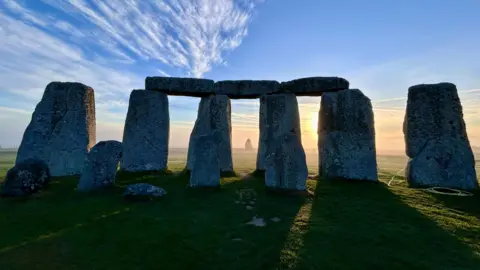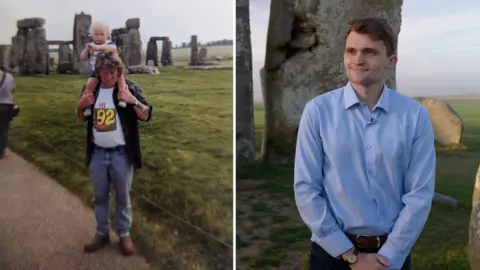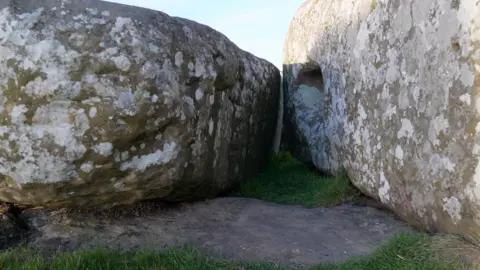Stonehenge: Central Altar Stone from Scotland not Wales

- by Admin
- August 14, 2024

 Dawn Pummintr/BBC
Dawn Pummintr/BBCThe six-tonne Altar Stone at the heart of Stonehenge came from the far north of Scotland rather than south-west Wales as previously thought, new analysis has found.
The discovery shows the construction of Stonehenge was a far greater collaborative effort than scientists realised.
It also means that the ancient monument, near Salisbury in south-west England, was built with stones from all parts of Great Britain.
The findings suggest Neolithic Britain was a far more connected and advanced society than earlier evidence indicated.
The distance between Stonehenge and the far north of Scotland is about 700km (434 miles).
The research was led by a Welsh PhD student, Anthony Clarke, now working at Curtin University in Western Australia.
Such is the importance of the discovery that it has been published in one of the world’s leading scientific journals, Nature, which is an enormous achievement for an apprentice researcher.
But it is a bittersweet moment for the young Welshman, who was born in Pembrokeshire, where the Altar Stone was until now thought to have come from.
“I don’t think I’ll be forgiven by people back home,” he joked to BBC News. “It will be a great loss for Wales!”
But Mr Clarke points out that the remaining stones in the central horseshoe, which are known as bluestones, are from Wales and the larger stones in the outer circle are from England.
“We’ve got to give the Scots something!” he said.
“But on a serious note, Stonehenge seems to be this great British endeavour involving all the different people from all over the island,” he said.

The bluestones at Stonehenge were identified as coming from the Preseli hills in Pembrokeshire in 1923, by Welsh geologist Henry Herbert Thomas. The central Altar Stone was made of a different rock but always assumed to have come from the same area, until 20 years ago when scientists first began to question its origins.
Last year, researchers including Prof Nick Pearce from Aberystwyth in Wales, of all places, concluded that the Altar Stone could not have come from Wales. But its origin had remained a mystery, until now.
“It blew our socks off when we discovered it was from north-east Scotland,” Prof Pearce, who was also involved in the current discovery, told BBC News.
“It was a shock to say the least. Coming from that distance, more than 700km, was remarkable.
“The Neolithic people must have been pretty well connected, far more connected than people give them credit for. They must have been very well organised”.
The breakthrough was made by the team at Curtin university who analysed the chemical composition of fragments of rock that had fallen off the Altar Stone and dated them. The composition and date are unique to rocks from different parts of the world, rather like a fingerprint.
The Australian team had access to one of the most comprehensive global rock fingerprint databases and found the best match was from the Orcadian Basin, which includes the Caithness, Orkney, and Moray Firth regions of north-eastern Scotland.
 Anthony Clarke
Anthony ClarkeConstruction at Stonehenge began 5,000 years ago, with changes and additions over the next two millennia. Most of the bluestones are believed to have been the first stones erected at the site.
Dr Robert Ixer, from University College London, who was also involved in the study, described the result as “shocking”.
“The work prompts two important questions: how was the Altar Stone transported from the very north of Scotland, a distance of more than 700 kilometres, to Stonehenge, and, more intriguing, why?”
The distance is the longest recorded journey for any stone used in a monument at that period and Prof Peace says that the next mystery to solve is how it got there.
“There are obvious physical barriers to transporting by land, and an equally daunting journey if going by sea.
“These findings will have huge ramifications for understanding communities in Neolithic times, their levels of connectivity and their transport systems”.
 Gwyndaf Hughes/BBC
Gwyndaf Hughes/BBCThe new research will be pored over by archaeologists working for English Heritage, which looks after Stonehenge, according to one of the monument’s senior curators, Heather Sebire.
”This discovery certainly implies that there were great social connections in Britain at the time,” she told BBC News.
“It is phenomenal that the people of the time brought such a large stone all this way. They must have had a compelling reason to do it.
“They had a sophisticated and developed society and so they probably had a spiritual side, just like we do“.
The Latest News
-
December 23, 2024Daily horoscope: December 23, 2024 astrological predictions for your star sign
-
December 23, 2024Sharp fall in UK business activity forecast as economic gloom deepens
-
December 22, 2024Foxtel offloaded to UK streamer for $3.5b
-
December 22, 2024Elon Musk’s British cousin reveals how brutally world’s richest man snubbed him: ‘I’m shocked that…’
-
December 22, 2024‘Labour will torpedo my firm’: One of Britain’s OLDEST family businesses says inheritance tax plans could destroy his finances in ‘blink of an eye’ after 250 years of trading






